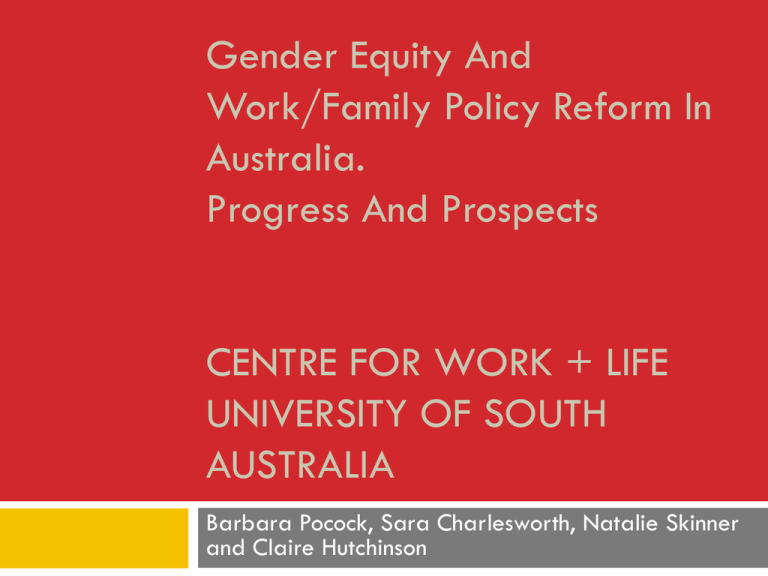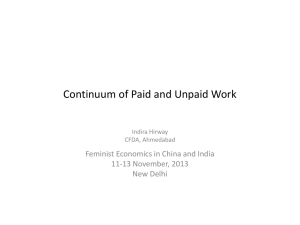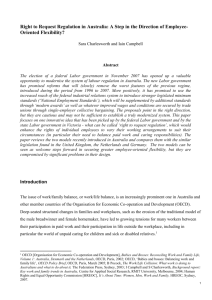
Gender Equity And
Work/Family Policy Reform In
Australia.
Progress And Prospects
CENTRE FOR WORK + LIFE
UNIVERSITY OF SOUTH
AUSTRALIA
Barbara Pocock, Sara Charlesworth, Natalie Skinner
and Claire Hutchinson
5 years of work-family reform…
In Australia
Driven by
claims and mobilisation of feminists, unionists, government, some in
business
Backed by a body of evidence and research
Encouraged by tight labour market and
Rising female participation, declining men’s
Reforms are modest in scope
But better than in many other places (eg US)
A strong economy at present perhaps enables more…
5 years of wide ranging reform…
1.
2.
3.
4.
5.
Government funded Paid Parental Leave
Government support for pay equity for some
categories of paid care workers
Extension of anti-discrimination protections for
workers with family responsibilities
Childcare reforms
Reform of labour law
National employment standards
National awards, overlaid with enterprise agreements
Including limited right to request flexibility (RTR)
However, continuing gender inequity
1.
2.
3.
4.
5.
Pay inequity (including in retirement income)
Women’s responsibility for unpaid, domestic work
Sex-segregation of occupations and
management/leadership
Declines in job quality for some (job security,
conditions)
Work/life pressures, time pressures especially for
mothers, carers
1. Pay equity
Women earn around 83% men’s earnings (full-time
average ordinary time earnings)
85%
in 2005
Most of the gap explained by ‘being a woman’
25% by industry segregation
Cost in labour market participation
Estimated
at A$93 bn (NATSEM, 2010), 8.5% GDP as
women work less because of lower pay
2. Responsibility for unpaid, domestic work
Women do twice as much as men. Persistently.
“Twenty-five
years of exhortations and demands have
not substantially increased the contribution made by
men to the total unpaid work performed…” (Bittman,
2010: 32)
Women adapt, do less, turn to market provision –
and that has narrowed the gender gap a little.
But it remains wide, despite convergence of
participation rates in paid work.
3. Sex-segregation of occupations and
management/leadership
Occupational sex-segmentation in Australia very
marked in international comparison
No signs of reduction
Growth in feminised services sector
Women’s share of leadership, management positions in
Australia very low by international comparison.
8.4% of ASX 200 board directors (lower than UK, UK Canada,
South Africa, New Zealand)
54% of ASX boards have no women
Lower share of Executive Key Management Personnel than US, UK,
Canada, South Africa.
4. Job quality (job security, conditions)
2 million casual workers in Australia (24% of labour
force)
Employed on a ‘shift to shift’ basis
Though
many work long term on this basis
More than half are women
No paid holidays or sick leave (a loading to
compensate – but does not adequately)
Poor conditions, low retirement benefits
5. Work/life pressures, time pressures
Mothers work-life conflict worse than amongst those working 48 hours a week or
working more than they would prefer
5 years of reform…
1.
2.
3.
4.
5.
Government funded Paid Parental Leave
Government support for pay equity for some
categories of paid care workers
Extension of anti-discrimination protections for
workers with family responsibilities
Childcare reforms
Reform of labour law
National employment standards
National awards, overlaid with enterprise agreements
Including limited right to request flexibility (RTR)
1. Government funded Paid Parental
Leave from 1 January 2011
18 weeks government funded Paid leave
At minimum wage (about $590 a week, pre-tax)
Others have more through employer, bargaining
Academics, public sector, large companies, banks…
From 1 Jan 2013, partner paid leave
If earn less than $150,000/yr
worked for at least 10 of the 13 months prior to birth
worked for at least 330 hours in that 10 month period (just over one day a
week) with no more than an 8 week gap between two consecutive working
days.
2 weeks
Unpaid leave:
If employed for 12 months or more prior to birth or adoption, entitled to up to
12 months unpaid parental leave.
Can also request an additional 12 months unpaid leave on top of this
2. Government support for pay equity for
some paid care workers
3. Anti-discrimination protections for
workers with family responsibilities
Anti-discrimination law from 1970s
Discrimination in employment on basis of race, sex and marital
status
Pregnancy and more recently care responsibilities added
Emergence in Victoria of new type of discrimination:
‘unreasonable failure to accommodate an employee’s care
responsibilities’
(Chapman, 2012: 5)
2011 Commonwealth and most states
discrimination on grounds of family responsibilities
extended beyond dismissal to all aspects of employment incl
promotion and hiring
Only ‘direct’ discrimination – not indirect
Victoria, NT and NSW (arguably) also include
‘an
obligation on employers to provide a level of
accommodation for an employee’s care responsibilities’
(Chapman 2012: 9)
Thus provide some avenues for greater support for
working carers
But
relies on individual complaints
Relatively small number of cases
Outcomes tend to reinforce care=women, not men/fathers
4. Childcare
Government funding has increased significantly
Growth in services
Financial assistance began in 1972 - $4.4bn in 2012/13 (DEEWR, 2010: 2)
Rationales: labour market participation and early childhood development
600,000+ families use
but shortages in some areas (eg under 2s in big cities)
Greater focus on quality
Means tested government subsidies to parents for approved
childcare – affordable for many families
Collapse of private provider (ABC Learning) has led to fall in forprofit share of provision, more stability
Current debate about subsidising nannies and providing taxdeductability – but minority, wealthy users…
5. Labour law reform - Right to request
Fair Work Act 2009
New ‘right to request’ (RTR) from1 Jan 2010
Gives working parents of preschoolers or children under 18 with a
disability the right to request flexibility
a duty for the employer to consider ‘reasonably’
Compared to other countries
‘light touch’, modest right, constrained access
Weak enforcement – only in relation to process
Similar in spirit to UK, the Netherlands, Germany
and New Zealand – but generally weaker
RTR and work-life outcomes?
Data
sources and methods: Australian Work and Life
Index surveys
2009, 2012 (and 2014 in the future)
Cross-sectional CATI surveys
AWALI 2009 N = 2691, AWALI 2012 N =2492
Random digit dialling; stratified random sample by geographic
location; quotas for gender & age
Representative sample of Aust. employed population.
50.6% response amongst those contacted by phone
Also
conducting interviews….
Who sought flexibility?
2009
Men
Women
All
16.3
29.1
22.4
Who sought flexibility?
Men
Women
All
2009
16.3
29.1
22.4
2012
17.3
24.2
20.6
Awareness of new right 2 years on
Majority not aware of RTR
Of parents of preschoolers
Only
a third of fathers aware
A quarter of mothers aware
So perhaps not surprising that we find no increase
in proportion of respondents seeking flexibility
Rates of request making, 2 years on
20.6% had made a request over previous 12
months - Down from 22.4% in 2009
Gender gap in request making narrowed
Men
– not much change
Women – smaller proportion asking
24.2% 2012, 29.1% 2009)
Slight increase for fathers of children under 5
19.8%
in 2012, 17.1% in 2009
Slight decrease for mothers of children >5
43.0%
in 2012, from 47.8% in 2009
Granting, refusal?
As pre-RTR, most are granted
61.9%
fully
19.1% partially
13.2% refused
Men more likely to be refused than women (17.4%
compared with 9.8% women)
Effect on work-life interference?
Significantly better when request granted for both
women and men
Fully granted much better for women than partially
granted
No difference for men
Worse work-life interference for those refused
Conclusion
Significant policy changes in Australia
But significant gender gaps remain
Time
pressures, pay gap, segmentation, domestic and
care work
Effectiveness of implementation of new policies
matters
Eg
Knowledge of new rights
And how they interact with other regulations (eg
awards, individual flexibility agreements) which may be
much more important in shaping gendered regimes of
work and care
Conclusion
Powerful gender cultures in workplaces and social life
work mean that gender inequalities are not necessarily
narrowed by particular policies
Especially where limited, individualised and not scrutinised
And some entrench gender inequality because women
remain responsible for sustaining work and family
And attempt to combine work and family life (eg through
part-time work and requests for flexibility) but do not
experience, as they do so, either
Improvements in the terms and conditions of paid work
Or more equal distribution of unpaid work and care
http://www.unisa.edu.au/Research/Centre-for-Work-Life/












